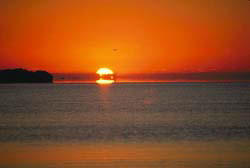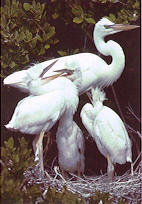|
Biogeochemistry Symposium
Monday, Tuesday and
Wednesday, July 28-30, 2008
Symposium on Biogeochemistry and
Water Quality of the Greater Everglades: Fate and
Transport of Nutrients and other Contaminants
Symposium
Objective:
 The objective of this symposium is to provide
a framework for synthesis and interpretation of the
research findings related to fate and transport of
nutrients and other contaminants in the Greater
Everglades Ecosystem The objective of this symposium is to provide
a framework for synthesis and interpretation of the
research findings related to fate and transport of
nutrients and other contaminants in the Greater
Everglades Ecosystem
The focus of the symposium will be to review our
current understanding on the role of biogeochemical
cycles in regulating the fate and transport of
nutrients and other contaminants as related to
ecosystem restoration and recovery. In addition new
approaches and techniques that link community
structure at the micro, and macro, scales to better
understand the mechanisms that control the fate of
chemicals at ecosystem scale will be discussed at
the symposium. The symposium will also review
current management strategies to abate the impact of
nutrients and other contaminants and identify key
water quality indicators to assess the recovery.
Symposium
Background:
 Excess
nutrients and other contaminant inputs from various
sources including agricultural and urban land use
activities, atmospheric deposition, and weathering
of natural minerals can significantly impact trophic
conditions of wetlands and aquatic systems in the
Greater Everglades ecosystem. Many biogeochemical
processes functioning in soil, water, periphyton,
and vegetation components influence fate and
transport of nutrients and other contaminants. The
scales at which many of the
biogeochemical processes
are studied vary, with some researchers conducting
studies at small-scale (microbial cell or particle
level or laboratory-scale), while others are
involved at a relatively large-scale (field-plot or
ecosystem level). Conclusions derived from the
studies conducted at different scales are usually
influenced by the disciplinary bias. Although, the
research conducted by each of these scientists is
very important, it lacks the linkage or common
targeted goal to solve the problem. At present,
there are no effective mechanisms to establish the
linkage between scientists and users of the
scientific information. Linkage among these groups
will provide an opportunity to exchange technical
information and will aid in effectively solving more
practical problems. Excess
nutrients and other contaminant inputs from various
sources including agricultural and urban land use
activities, atmospheric deposition, and weathering
of natural minerals can significantly impact trophic
conditions of wetlands and aquatic systems in the
Greater Everglades ecosystem. Many biogeochemical
processes functioning in soil, water, periphyton,
and vegetation components influence fate and
transport of nutrients and other contaminants. The
scales at which many of the
biogeochemical processes
are studied vary, with some researchers conducting
studies at small-scale (microbial cell or particle
level or laboratory-scale), while others are
involved at a relatively large-scale (field-plot or
ecosystem level). Conclusions derived from the
studies conducted at different scales are usually
influenced by the disciplinary bias. Although, the
research conducted by each of these scientists is
very important, it lacks the linkage or common
targeted goal to solve the problem. At present,
there are no effective mechanisms to establish the
linkage between scientists and users of the
scientific information. Linkage among these groups
will provide an opportunity to exchange technical
information and will aid in effectively solving more
practical problems.
Symposium
Topics:
Sources and types of nutrients and
contaminants
-
Types of
nutrients and other contaminants
(phosphorus, nitrogen, carbon, sulfur,
mercury, pesticides, emerging
contaminants, and others)
-
Anthropogenic sources
-
Atmospheric
deposition
-
Natural
weathering of minerals
-
Internal load
Spatial distribution of nutrients and
contaminants
-
Landscape patterns of water column
nutrients and other contaminants
-
Landscape patterns of vegetation
-
Landscape patterns of periphyton
-
Landscape patterns of soil nutrients
and other contaminants
Biogeochemical transformations
|
Biogeochemical responses
-
Microbial communities
-
Periphyton
-
Vegetation
-
Other biotic communities
Transport processes
-
Hydrologic processes uplands
-
Hydrologic processes in
wetlands
-
Hydrodynamic processes in
shallow lakes
-
Transport processes of
nutrients and other
contaminants
Remediation and management
of nutrients and other
contaminants
-
Long-term water quality
trends
-
Stormwater treatment
areas
-
Chemical treatment
systems
-
Biogeochemical modeling
Synthesis
-
Indicators of
ecosystem recovery
-
Mechanistic
biogeochemical
models
-
Ecosystem models
…that include the
fate of
biogeochemical
parameters,
responses and
recovery
-
Landscape models for
spatial scaling
biogeochemical
parameters
|
NOTE: There is no fee to participate in this
symposium. Please sign up in advance when registering
online for the GEER meeting.
For
more information, contact the Symposium
Organizer:
Dr. K. Ramesh Reddy
Meeting Organizer and Chair
Soil and Water Science Department
University of Florida/IFAS
PHONE: 352-392-1804 ext
EMAIL:
krr@ufl.edu |
Dr. G. Ronnie Best
Meeting Chair
- Technical Sessions
Coordinator,
Greater Everglades Priority Ecosystems
Science
United States Geological Survey
c/o University of Florida/IFAS
Fort Lauderdale Research and
Education Center
3205 College Avenue
Fort Lauderdale, FL 33314-7799
PHONE:
954-577-6354
FAX: 954-577-6347
PHONE
(CELL):
954-658-4676
EMAIL:
Ronnie_Best@usgs.gov
WEB SITE:
SOFIA.usgs.gov |
|